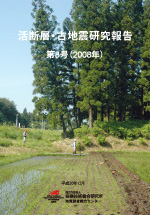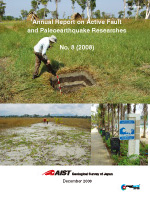Active Fault and Paleoearthquake Researches No. 8 (2008)
Cover |
Back cover |
BackCover figure
Research on tsunami deposits in Thailand
Top: A dug pit in Phra Thong Island, south Thailand. Grey part is tsunami sandy deposits and brown is peat. Upper deposit is generated from the 2004 tsunami and lower is from previous tsunami (postdating 550-700 yBP).
Bottom left: There remains a lot of piles of tin mining in Phra Thong Island. The piles produce sand streak, of which direction (west-east) is consistent with tsunami from Indian Ocean.
Bottom right: Phuket coast in 2007. A sign cautions people to evacuate to high ground when earthquake occurs. (photo by Yuki Sawai)

Geological Survey of Japan, AIST
- About GSJ
- Our Activities
- Purchase guide
-
Publications and Database
- information
- Bulletin of the Geological Survey of Japan
- bull2025(Vol.76)
- bull2024(Vol.75)
- bull2023(Vol.74)
- bull2022(Vol.73)
- bull2021(Vol.72)
- bull2020(Vol.71)
- bull2019(Vol.70)
- bull2018(Vol.69)
- bull2017(Vol.68)
- bull2016(Vol.67)
- bull2015(Vol.66)
- bull2014(Vol.65)
- bull2013(Vol.64)
- bull2012(Vol.63)
- bull2011(Vol.62)
- bull2010(Vol.61)
- bull2009(Vol.60)
- bull2008(Vol.59)
- bull2007(Vol.58)
- bull2006(Vol.57)
- bull2005(Vol.56)
- bull2004(Vol.55)
- bull2003(Vol.54)
- bull2002(Vol.53)
- bull2001(Vol.52)
- Bulletin of the Geological Survey of Japan(old)
- Annual Report on Active Fault and Paleoearthquake Researches
- Reports, Geological Survey of Japan
- CCOP-GSJ Groundwater Project Report
- CCOP Technical Bulletin
- Cruise Report
- Geological Hazards
- Learning and Education
- GSJ Database Collection
- Collection of links

